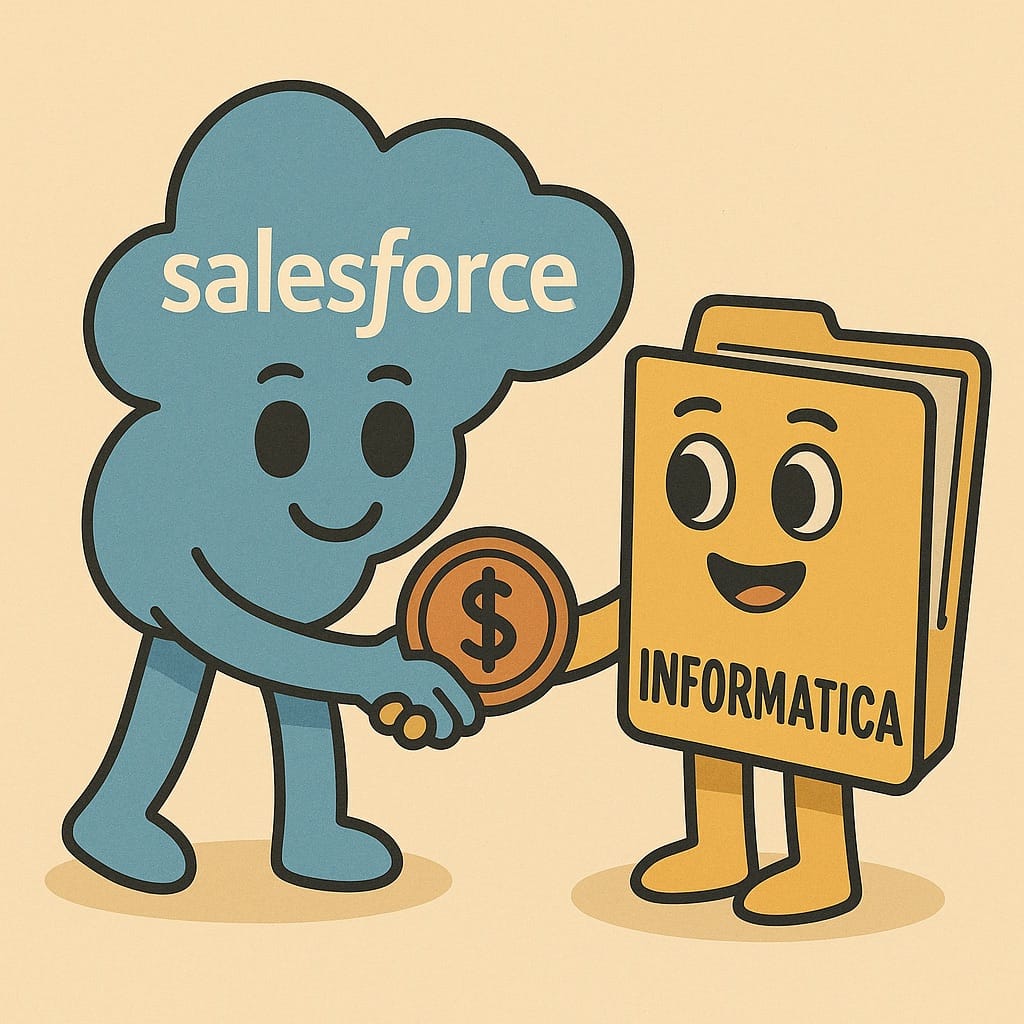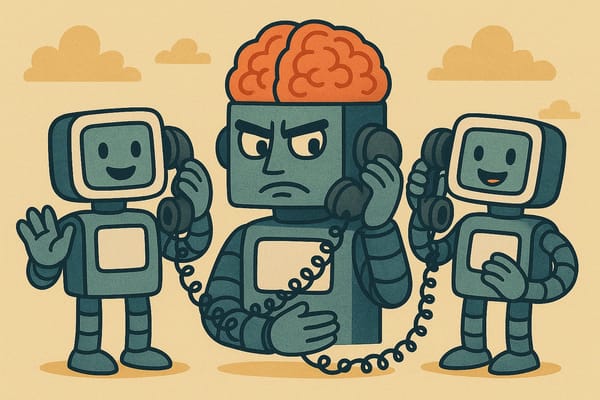The Real Reason Salesforce Bought Informatica
This is more than corporate consolidation—it signals the enterprise AI market's evolution toward integrated, business-ready platforms

Picture this: You've built the world's most sophisticated robot butler, capable of anticipating your every need. There's just one problem—it doesn't know where you keep the coffee. Or what coffee is. Or that you even drink coffee. This, in essence, is the enterprise AI predicament that Salesforce just spent $8 billion to solve.
On May 27, 2025, Salesforce announced its acquisition of Informatica, the company that makes the digital plumbing nobody thinks about until their AI starts hallucinating customer names. At $25 per share—a 30% premium that would make a Manhattan real estate broker blush—Marc Benioff essentially bought the entire Home Depot of data infrastructure. And in a world where AI is the new electricity, somebody needs to sell the wiring.
The Context Layer Becomes the New Oil (But Less Messy)
Think of it this way: if AI systems are becoming the new interface layer (as we explored in our conversations about talking to machines), then clean, connected, contextual data isn't just helpful—it's existential. Informatica isn't sexy technology; it's the digital equivalent of sewage treatment. But when your entire house is about to become sentient, suddenly the plumbing matters a lot more.
What Salesforce is really buying here is the ability to create what I'd call "ambient context"—the substrate that allows AI systems to understand not just what you're asking, but what you actually need. It's the difference between a system that knows you have a meeting with Acme Corp tomorrow and one that understands Acme Corp is your biggest client, they're unhappy about recent service issues, tomorrow's meeting is make-or-break for the renewal, and your sales team needs three specific data points before walking into that room.
The numbers tell the story: Informatica processes 110.7 trillion cloud transactions monthly. That's not a typo. That's more transactions than there are stars in our galaxy, though admittedly less poetic. They hold 25% of the master data management market and have been Gartner's leader in data integration tools for 19 straight years—the Tom Brady of making disparate systems talk to each other.
Why Now? Because Yesterday's Science Fiction Is Today's Infrastructure Problem
Here's the delicious irony: We've reached a point where 78% of organizations use AI in at least one business function, up from 55% in 2023. Yet 74% struggle to scale AI because—wait for it—their data is a mess. It's like having a Ferrari engine in a car with square wheels.
The enterprise data integration market, valued at $15.5 billion in 2024 and projected to reach $42.3 billion by 2033, suddenly looks less like boring middleware and more like the foundation for the next industrial revolution. Except instead of coal and steel, we're dealing with bytes and business logic.
This acquisition addresses what I call the "Great AI Disappointment of 2024"—that awkward moment when companies realized their shiny new AI couldn't actually do anything useful because it couldn't access clean data. 25% of organizations cite data complexity as their top AI adoption barrier, while 86% report needing tech stack upgrades. It's the corporate equivalent of buying a smartphone and realizing you still have dial-up internet.
The Semantic Layer: Or How to Teach Machines What Things Mean
Let's talk about semantic layers—a term that sounds like something a pretentious barista would say but actually matters. A semantic layer is essentially a translator between the Tower of Babel that is enterprise data and the AI systems trying to make sense of it all. It's the difference between knowing that "Q3RevActuals_v2_FINAL_FINAL_really" is a number and understanding it represents last quarter's revenue that three different executives have blessed.
Informatica's CLAIRE engine (their AI that helps AI understand data—yes, it's AIs all the way down) can enhance data discovery 100x faster and reduce classification time by 50%. In practical terms, this means the difference between your AI assistant saying "I found 47 different customer records for John Smith" and "Here's John Smith from Acme Corp, and by the way, he prefers to be called Jack and hates phone calls on Mondays."
The Chess Game: Everyone Else Scrambles for Position
The acquisition fundamentally rewrites the enterprise software playbook. Microsoft, with its Fabric unified analytics platform, suddenly looks like it brought a knife to a gunfight. Google Cloud, despite BigQuery's technical elegance, finds itself in the position of having built the world's best engine but forgetting about the transmission. AWS, ever the infrastructure titan, must be having emergency meetings about how to make SageMaker less like assembling IKEA furniture.
Oracle—bless their hearts—continues to position Fusion Data Intelligence as the answer, which is like suggesting a Swiss Army knife when someone needs a proper toolkit. Meanwhile, Databricks and Snowflake, the wunderkinds of data engineering, suddenly look less like disruptors and more like really talented specialists who forgot to think about the bigger picture.
The Art of Timing: When $8 Billion Is Actually Prudent
Here's where it gets interesting. Salesforce tried this dance before. In April 2024, talks fell apart when they were discussing prices in the mid-$30s per share. After activist investor pressure in 2023 led to dismantling their M&A committee, Salesforce learned patience. The eventual $25 per share agreement reflects what CFO Amy Weaver called being "methodical, patient, and decisive"—corporate speak for "we waited until the price was right."
The timing also reflects a broader truth: the AI hype cycle has crested. We're in that beautiful moment between "AI will solve everything" and "AI is a disappointment" where actual infrastructure work happens. It's like the internet in 1997—past the "information superhighway" breathlessness but before the dot-com crash, when people were quietly building the systems that would actually matter.
The $297 Billion Question: Who Owns the Context Layer?
Global AI software spending will surge from $124 billion in 2022 to $297 billion by 2027, but here's the thing—most of that money is currently being lit on fire. Only 47% of organizations with AI strategies report positive ROI, though the successful ones see returns of $3.50 to $8 per dollar invested.
The pattern is clear: organizations achieving 20-30% gains in productivity focus on the boring stuff—data quality, integration, governance. The ones chasing shiny AI objects? They're the ones contributing to that 74% failure rate. As BCG's research shows, leaders invest 70% in people and processes, only 20% in technology. Turns out, even in the age of artificial intelligence, success is surprisingly human.
The Unified Theory of Everything (At Least in Enterprise Software)
What Salesforce understands—and what this acquisition crystallizes—is that the future of enterprise AI isn't about who has the smartest models. It's about who can make those models actually useful in the messy reality of business. It's the difference between having a brilliant consultant who knows nothing about your company versus one who's been embedded in your operations for years.
By combining Informatica's data expertise with Salesforce's Einstein Trust Layer and Agentforce platform, they're creating what Marc Benioff calls "the ultimate AI-data platform." That's corporate hyperbole, of course, but it's hyperbole with a point.
The real magic happens when you connect this to Salesforce's existing assets—MuleSoft for application integration, Tableau for visualization, and their various clouds for everything else. It's less a product portfolio and more a full-stack assault on the enterprise AI problem.
The Bottom Line: Infrastructure Is Destiny
This acquisition signals something profound: we're moving from the "gee-whiz" phase of AI to the "okay, but how do we actually make this work?" phase. And in that transition, the boring stuff—data quality, integration, governance—becomes the most important stuff.
It's like the shift from horse-drawn carriages to automobiles. Everyone got excited about the engines, but the real money was in building roads, gas stations, and traffic systems. Salesforce just bought the company that makes the traffic lights for the AI highway.
In a world where every company is becoming a data company, and every data company is becoming an AI company, owning the context layer might be the ultimate power move. Because at the end of the day, artificial intelligence without artificial wisdom is just very expensive pattern matching. And wisdom, as we've always known, is just intelligence plus context.
The revolution isn't in making AI smarter. It's in making it more contextually aware. And in that race, whoever owns the plumbing might just own the future.
After all, when your digital butler finally knows where you keep the coffee, who made the coffee maker matters a lot less than who taught it what coffee is.




